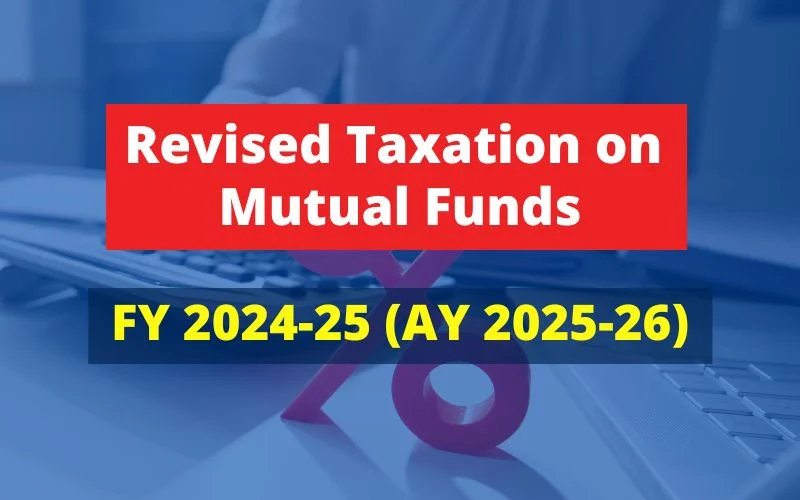Mutual Fund is a financial instrument that pools money from investors and helps them invest in an asset class such as equity, debt, or gold. Investors who want to invest in a security market but need more time and expertise can invest through a mutual fund.
When you start investing in the mutual fund, you choose to take the services of the fund manager, who will make the investment decisions relating to the securities selection, the investment time, reviewing and rebalancing the portfolio periodically, and executing the operational decisions related to the portfolio. These services are provided to you (the investor) by charging a fee called fund management charges.
The excellent part about mutual funds is that it allows the investor to begin their investment with a small amount. You can start monthly SIP with as small as Rs. 500 per month, a one-time investment of Rs. 5,000, and an additional investment in most of the funds multiple of Rs. 1,000.

Mutual Fund Types
Several mutual fund types are available in India, each with unique investment strategies and risk-return profiles. Based on SEBI circular, the mutual fund has been broadly categorized into five groups: (a) Equity Schemes, (b) Debt Schemes, (c) Hybrid Schemes, (d) Solution Oriented Schemes (e) Other Schemes.
| Category | Scheme |
|---|---|
| Equity | Large-cap, mid-cap, Flexi-Cap, ELSS, etc |
| Debt | Liquid Fund, Short term debt fund, etc |
| Hybrid | Hybrid fund, Arbitrage Fund, etc |
| Solution Oriented Schemes | Retirement fund, Child fund, etc |
| Other Schemes | ETFs, Index Funds, Funds of Funds, etc |
Some of the most common mutual funds types in India include:
Equity Funds
Equity mutual funds invest primarily in stocks of companies listed on the stock exchange. They are the riskiest type of mutual fund, as the fund’s value is linked directly to the performance of the underlying equities. Equity funds are further classified based on the market capitalization of the companies they invested in, such as large-cap, mid-cap, Flexi cap, and small-cap funds. Equity funds are also classified based on the sectors they invest in, such as technology, healthcare, banking, or infrastructure funds.
– Large Cap Funds
Large Cap Funds are those mutual funds that invest a larger proportion of their investment corpus in companies with a large market capitalization (i.e, above Rs. 20,000 Crores). Examples of a few large-cap companies are – Reliance Industries, HDFC Bank, TCS, Infosys, etc.
– Mid Cap Funds
Mid-Cap Funds are those mutual funds that invest a larger proportion of their investment corpus in companies with a medium size market capitalization (i.e. between – Rs. 5,000 – Rs. 20,000 Crores). Examples of a few mid-cap companies are – Adani Power, Aditya Birla Capital, etc.
– Flexi-Cap Funds
Flexi-cap mutual funds invest at least 65% of their total assets in equity and equity-related instruments. Hence, they are considered to be high-risk options.
– Tax Saving Funds
A tax saving fund, also known as Equity-Linked Saving Scheme (ELSS), invests primarily in equities and provides tax benefits to investors under the Section 80C of the Income Tax Act. They are considered a very risky option, as they invest primarily in equities but also provide the added benefit of tax savings. In accordance with Equity Linked Saving Scheme, 2005, notified by the Ministry of Finance, ELSS invests at least 80% in stocks and has a three years lock-in period (the shortest amongst all other tax saving options).
– Sector Funds
A sector fund is also known as a thematic fund, and as per SEBI guidelines, in this fund, at least 80% of investment needs to be in stocks of a particular sector/ theme. These funds invest in stocks of companies belonging to a specific sector or industry, such as technology or banking. They are considered a high-risk option, as they are highly concentrated in one particular sector and, therefore, more susceptible to market fluctuations in that sector.
Debt Funds
Debt funds invest primarily in fixed-income securities such as bonds and government securities. They are considered less risky than equity funds, as the fund’s value is not linked directly to the performance of the underlying securities. Debt funds are further classified based on the type of security they invest in, such as government bonds, corporate bonds, or money market instruments. Debt funds are also classified based on the duration of the securities they invest in, such as short-term, medium-term, or long-term funds.
– Short-term Debt Funds
The objective of the Short-term debt fund is to generate a stable and low-risk return by investing in a short duration and money market duration between 1 year – 3 years.
Hybrid Funds
Hybrid funds invest in a mix of equity and debt securities to provide growth and stability. They are considered to be a moderate risk option, as they provide a balance between the potential for growth and stability. Hybrid funds are also known as balanced funds, as they combine the characteristics of both equity and debt funds.
– Arbitrage Fund
Arbitrage Fund follows an arbitrage strategy, with a minimum 65% investment in equity & equity-related instruments. An arbitrage fund falls under the hybrid category as the underlying asset for arbitrage is more than 50% in equity; that’s why an arbitrage fund is treated as an equity-oriented fund for taxation. However, from the risk point of view, it is a low-risk investment.

Solution Oriented Funds
– Retirement planning fund
Retirement planning mutual fund is a solution-oriented mutual fund where the focus of this scheme is retirement and comes with a lock-in of 5 years. This means if someone is planning to retire early, having min 5 years in hand, they can consider this fund.
– Children’s gift mutual fund
Children’s gift mutual fund focus on building a corpus for your children’s future with a lock-in period of at least 5 years or till the child attains the age of majority.
The scheme aims to generate returns over the long term and to maintain risk under control. This fund can be allocated toward child higher education and marriage goals.
Other Schemes
– International Funds
These funds invest in securities listed on foreign stock exchanges. International equity funds may also have some holding of their portfolios in Indian debt or equity. They are considered to be a high-risk option, as they are exposed to the fluctuations of both the domestic and foreign markets. However, it gives investors additional benefits of diversifying their portfolio in Indian & global markets.
– Index Funds
These funds replicate the performance of a specific stock markets index, such as the Nifty 50 or the BSE Sensex. They are considered a low-cost and low-risk option, as they do not require active management and track the performance of the underlying index.
– Gold Funds
These funds invest in gold or gold-related securities such as gold ETFs (Exchange Traded Funds). Investing in Gold ETF is as easy as buying a stock. To buy Gold ETF, you need to have a Demat account. It is convenient as you can hold the gold in electronic format and sell it whenever you wish to without physically holding it with no risks of theft or purity. For the purpose of taxation, Gold ETFs are treated as non-equity-oriented mutual funds, and the taxation of debt funds will be implemented in them. Gold funds are considered a moderate risk option, as they hedge against inflation and currency fluctuations.
Learn to choose the right mutual fund for you
The moment you start thinking about investing in the right mutual fund rather than chasing a return, that is a sign that your financial literacy has increased one level. You can choose the right mutual fund only when you understand your goals and risk appetite.
| Investment Term | Goals | Mutual Fund Types | Risk Involved |
|---|---|---|---|
| Short-term goals (Less than 3 years) | Emergency fund, vacation planning, etc | Liquid funds, Arbitrage funds | Low |
| Medium-term goals (Within 3-6 years) | Bike or Car purchase, own marriage, honeymoon trip, etc. | Medium-term debt funds, Hybrid / balanced funds, index funds, etc. | Moderate & High (depending on scheme) |
| Long-term goals (More than 6 years) | House purchase, Child education, Retirement planning, etc. | Large-cap funds, Mid cap funds, Flexi cap funds, etc. | Very High |
- It gives you clarity.
- You know the reason for investing.
- You take calculated risks.
- You get peace of mind.
Conclusion
It is essential to be aware that these are not the only types of mutual funds available in India, each with its unique investment strategies and risk-return profiles. There is an extensive list. However, I chose to explain the schemes that can help you achieve your goals. Choose your investment based on your goals and risk appetite.
Happy investing in mutual funds.
Important Articles related to Personal Finance
- Money management tips for beginners
- Tax Planning For Salaried Employees
- Investment Planning For Salaried Employees
- Mutual Fund KYC Online Registration
- How To Invest In Direct Mutual Funds?
- How To Start SIP Investment In Mutual Funds?
Important Calculators
Frequently Asked Questions
What are the 5 types of mutual funds?
Based on SEBI, the mutual fund has been broadly categorized into five groups: (a) Equity Schemes (b) Debt Schemes (c) Hybrid Schemes (d) Solution Oriented Schemes (e) Other Schemes
What are equity mutual funds?
Equity mutual funds invest primarily in stocks of companies listed on the stock exchange. They are the riskiest type of mutual fund. Based on the market capitalization of the companies, equity funds are classified as large-cap, mid-cap, Flexi cap, and small-cap funds.
What are debt mutual funds?
Debt funds invest primarily in fixed-income securities such as bonds and government securities. They are considered less risky than equity funds, as the fund’s value is not linked directly to the performance of the underlying securities.
What are hybrid mutual funds?
Hybrid funds invest in a mix of equity and debt securities. Hybrid funds are also known as balanced funds, as they combine the characteristics of both equity and debt funds.





